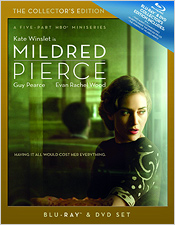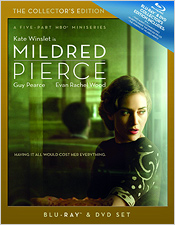Mildred Pierce: The Collector's Edition (Blu-ray Review)

Director
Todd HaynesRelease Date(s)
2011 (January 3, 2012)Studio(s)
HBO- Film/Program Grade: A
- Video Grade: B+
- Audio Grade: C+
- Extras Grade: A
Review
Classic film fans want to know! How does HBO's Mildred Pierce 2011 TV miniseries stack up compared to the 1945 theatrical feature version?
When you're up against the memory of a formidable filming of a best seller such as that of Michael Curtiz's 1945 Warner Bros. production of James Cain's novel "Mildred Pierce" starring Joan Crawford in the title role, it's an impressive feat indeed that we have in Todd Haynes' miniseries version of the book. Haynes' filming was broadcast on HBO early in 2011 and it has now been brought impressively to Blu-ray by HBO Home Video.
Author James M. Cain was well-known for his hard-bitten, tough-guy novels of the 1930s - titles such as "Double Indemnity" and "The Postman Always Rings Twice," both of which would later be made into successful films at Paramount and MGM, respectively. In 1941, Cain departed somewhat from his formula to write "Mildred Pierce," which offered a tale set in the 1930s of the rise and fall of a well-defined female protagonist. The title character, Mildred, divorces her husband Bert and tries to succeed as a single mother of two girls, Ray and Veda. She has a blind spot for an ungrateful Veda whom she tries to groom as a concert pianist. Mildred takes a job as a waitress while making pies as a sideline. The combination eventually leads to her success in opening a restaurant which becomes a chain, and a relationship with failing rich scion Monty Beragon whom she starts to bankroll. As written, the book lacked a strong dramatic climax and, with some strong sexual content and the moral degeneration of the title character, seemed a difficult source for a successful film in 1945, given the restrictive nature of the Production Code of the time as overseen by the Breen Office.
Jerry Wald, then a producer at Warner Brothers, felt strongly about the book's film potential. He envisaged the idea of a climactic murder, the restructuring of the story using flashbacks, and the maintenance of a generally higher moral tone to the film than had the original story. As a result, he was able to get a cautious go-ahead from the Breen Office and so, studio head Jack Warner finally approved the purchase of the novel in early 1944.
Even with Wald's ideas, it took eight different screenplays from a succession of writers before settling upon a satisfactory version. With Michael Curtiz directing and Joan Crawford in her first starring role at Warners, the film took 12 weeks to shoot in the winter of 1944-45. The completed film opened in New York in late September 1945 (it was held back purposefully until the end of World War II in hopes that it would find a more sympathetic audience in the postwar atmosphere) and was immensely popular with filmgoers, though critical reaction at the time was somewhat mixed. (More recent critical evaluation is almost universally positive.) Mildred Pierce received six Academy Award nominations including one for Best Picture, but the only win was for Joan Crawford as Best Actress.
Against that background from some 66 years ago, HBO's new version has been able to be much more explicit in spelling out the aspects of the novel that previously had had to be glossed over. As a 5-part miniseries lasting some 344 minutes in total, it has also had the luxury of being able to include much more plot detail than the 1945 feature film. Much of the miniseries' dialogue is lifted directly out of the source novel. According to director Todd Haynes, part of the inspiration for revisiting Cain's novel was the 2008 economic downturn that raised the spectre of the great Depression era, the time in which "Mildred" Pierce was set.
It almost goes without saying that the production design is impeccable. It's extremely difficult to caption in colour the essence of a recent time period that is so closely associated with black and white on films and documentaries of it. There is no such problem here because colours are somewhat muted yet true to life. The cinematography makes effective use of dust-daubed window reflections to help capture the era's at-times helplessness and sense of neglect. Locations and sets convey a realistic 1930s feel with costuming and prop selection looking dead on. The musical score by Carter Burwell also nicely places the viewer in the era.
The casting is a particular strength. Kate Winslet has the title role and she appears in nearly every scene of the film, delivering a magnificently layered and nuanced performance that comes about as close to making one forget Joan Crawford's efforts as is possible (and that is said in a positive sense, for I for one have always been greatly impressed by Crawford's work in the 1945 film). The work of the Warner stock company was another of the feature film's strong points, with Jack Carson (Wally), Zachary Scott (Monty Beragon), Eve Arden (Ida), and Bruce Bennett (Bert Pierce) all excelling in their parts. None of their counterparts in the miniseries - James LeGros (Wally), Guy Pearce (Monty), Mare Winningham (Ida), and Brian O'Byrne (Bert) - outshine the Warner players, but they are all strong in their own right, partly because the parts are somewhat more meaty (explicit) than had been possible on screen six decades ago. I would have said that Ann Blyth's efforts as Veda in the film could not likely have been surpassed, but the combination of a precocious Morgan Turner and Evan Rachel Wood actually manages it.
Both HBO's miniseries of Mildred Pierce and Warners' theatrical feature are excellent realizations of the story and it is not reasonable to try to say that one is better than the other. The two are entirely different beasts in tone, style, dramatic structure, and even story. Revel in the fact that both exist and can be equally appreciated for the entertainment value they provide.
It is to be hoped that Warner Bros. will see fit to release the Joan Crawford feature on Blu-ray soon. Meanwhile we have the HBO Miniseries Blu-ray effort to admire. The Collector's Edition packaging reminds one of a book in the way it opens, to reveal both a two-disc Blu-ray set and a two-disc DVD set. The 1.78:1 Blu-ray image is really good-looking considering the filmed source - 16mm, intended to help recreate a 1930s feel to the production's look. There is some occasional softness as a result and at those times, the image lacks the sharpness one associates with Blu-ray. Placed in the context of the filmmakers' intent, though, the Blu-ray recreates the original broadcast look admirably. Film grain is pleasingly evident, but never intrusive.
The DTS-HD 5.1 Master Audio track delivers effectively too. There is a modest degree of subtle ambient sound, both in the sound effects and background music. Dialogue is clear and well balanced, with some directionality even apparent occasionally. LFE are almost non-existent, with the exception of an effective thunderstorm sequence. French 5.1 DTS Surround and Spanish 2.0 DTS Surround tracks are included as are nine different sets of subtitles (including English SDH, French, and Spanish).
The main supplements are two audio commentaries, to be found with episodes 3 and 5. They include participation by director/writer Todd Haynes, production designer Mark Friedberg, and writer Jon Raymond. In total, they provide an interesting and quite thorough coverage of what went into the production. There is also a half-hour-long making-of documentary that involves both cast and crew in discussing the various aspects of how the miniseries came about. The effort is mercifully light on self-congratulation and mutual admiration. The final supplement consists of short plot and character discussions by Todd Haynes, one of which accompanies and is specific to each episode.
Highly recommended.

